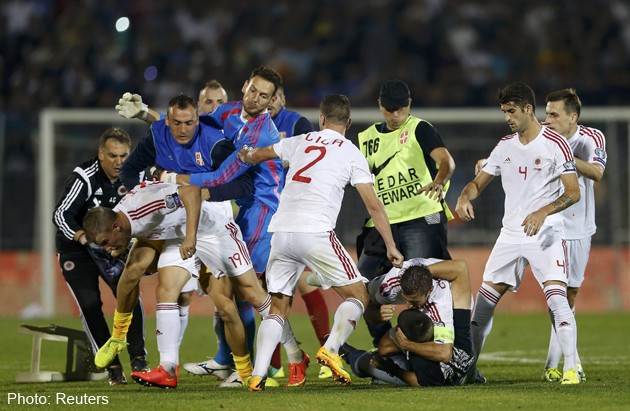Football: Belgrade disgrace


If there has ever been a more surreal cause for a football match to be abandoned, it must have been quite something.
Yesterday morning (Singapore time) in Belgrade, Serbia's Group I clash with Albania was brought to a premature end when a radio-controlled drone, reportedly piloted by Olsi Rama, the brother of Albanian Prime Minister Edi Rama, flew a politically sensitive flag over the pitch and sparked an on-pitch brawl that involved players, officials and fans.
But, as much as the incident sounds like a storyline from a particularly abstract episode of the Simpsons, it couldn't be any more serious.
As both sides scream for justice, Uefa will need to tread lightly. Political situations do not come much more delicate than this.
First the facts: Just before half-time, with the game still goalless, the drone appeared above the pitch.
Underneath it was a large flag marking out the territory which some refer to as "Greater Albania", an area across the Balkans which contains ethnic Albanians and which includes, among other territories, Kosovo, the partially-recognised state that declared independence from Serbia in 2008 after several years of bloody conflict.
The flag was grabbed by Stefan Mitrovic, the Serbian defender, but was immediately snatched away by a number of Albanian players, ending up in the hands of their striker Bekim Balaj.
He made for the touchline, but his progress was ended abruptly when a Serbian supporter ran onto the pitch and hit him over the head with a chair.
Lorik Cana, the Albanian captain, jumped onto the supporter and swung at least five punches at him while around him, fights broke out like wildfire.
OUT OF CONTROL
With stewards and police slow to react, it fell to the Serbian players to implore their supporters to return to their seats.
Seizing the moment, the Albanian players and officials made a break for the sanctuary of the tunnel, but were bombarded with objects from the crowd.
One topless Serbian supporter ran from the stands, crashed into them at the tunnel entrance and sent them sprawling to the ground.
At no point did the stewards or the police appear to have the situation under control and there was no surprise when Martin Atkinson, the English referee, abandoned the match, having failed to convince the Albanians to re-enter the pitch.
The facts are clear. What is less clear is quite what Uefa will do about this.
Its president Michel Platini moved quickly to signal his dissatisfaction.
"Football is supposed to bring people together and our game should not be mixed with politics of any kind. The scenes in Belgrade were inexcusable. Football should never be used for political messages. I strongly condemn what happened in Belgrade last night."
A disciplinary case was opened by Uefa yesterday.
It is unlikely that the outcome will be as simple as the one suggested off the record by the Serbian FA - that the game would be awarded to Serbia as a 3-0 victory.
With a history of crowd trouble, it would not be surprising if Uefa chose to shut their national stadium for a number of games. In 2010, Uefa awarded Italy a 3-0 victory after Serbian fans caused trouble in Genoa. In 2012, Serbia were charged after English players were racially abused in an Under-21 clash.
It will not have escaped Uefa's notice that the match kicked off to a soundtrack of murderous chants about Albanians.
Albania will not escape punishment either. Uefa takes a dim view of highly charged political banners and messages and there may also be recriminations for Albania's refusal to restart the game.
As for the allegation that Olsi Rama controlled the offending drone, that may rumble on for years.
The Serbian authorities confirmed that Rama was arrested in the VIP section but released later. Observers claimed that there was no visible confrontation in that part of the stadium.
In a dispute so loaded with history, hatred and horror, there won't be any easy answers at any level of this investigation.

This article was first published on Oct 16, 2014.
Get The New Paper for more stories.